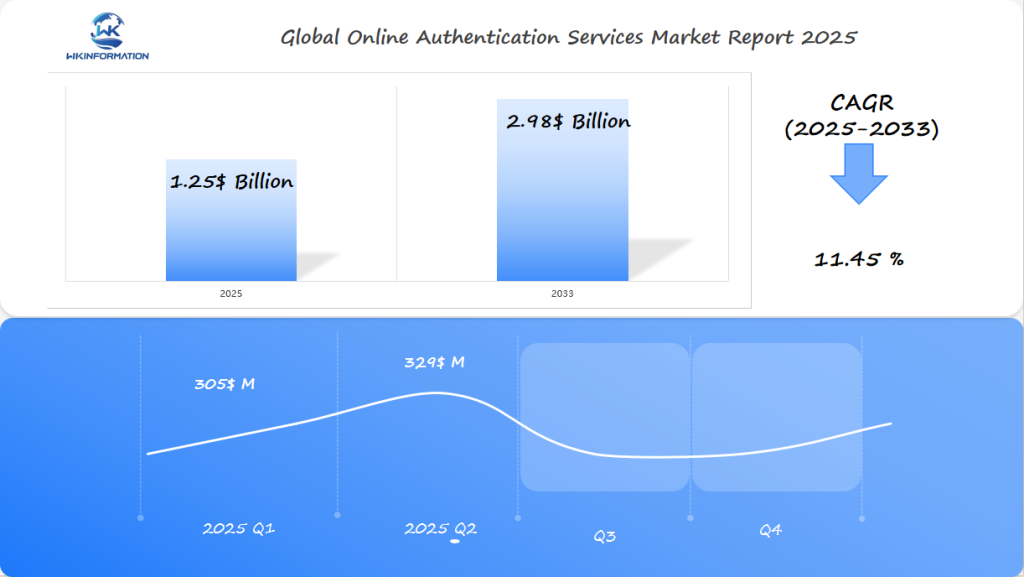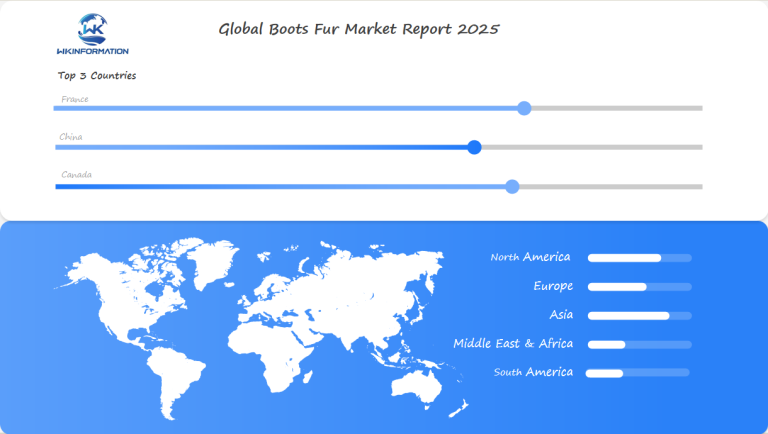Online Authentication Services Market to Exceed $1.25 Billion Globally by 2025: Security Focus in the U.S., India, and Germany
Explore the rapid growth of the Online Authentication Services Market as businesses prioritize cybersecurity. Latest trends, key players, and market dynamics driving industry expansion.
- Last Updated:
Online Authentication Services Market in Q1 and Q2 of 2025
The Online Authentication Services market will reach approximately $1.25 billion in 2025, growing at a strong CAGR of 11.45%. Q1 revenue is forecasted at $305 million, rising to $329 million in Q2. In the U.S., financial services and e-commerce are investing in secure identity platforms to curb fraud. India’s growing digital infrastructure and government-backed digital ID systems are key growth enablers. Germany emphasizes enterprise-grade authentication solutions that comply with GDPR and cybersecurity directives. Features such as passwordless login, biometric recognition, and behavioral analytics are becoming widespread.

Key Takeaways
- Online authentication market expected to reach $1.25 billion by 2025
- U.S., India, and Germany lead global cybersecurity investments
- Increasing focus on advanced verification technologies
- Digital security becoming a critical business strategy
- Technological innovations driving market transformation
Mapping the Upstream and Downstream Industry Chain of Online Authentication Services Market
The online authentication services market is a complex web of technology and stakeholders. Providers are key in creating advanced security solutions. These solutions protect digital interactions in many sectors.
The industry chain has several main parts:
- Upstream Technology Providers
- Software development firms
- Cybersecurity research laboratories
- Hardware manufacturers
- Midstream Solution Developers
- Authentication protocol designers
- Encryption technology specialists
- Cloud security infrastructure creators
- Downstream End-Users
- Enterprise IT departments
- Financial institutions
- Healthcare organizations
- E-commerce platforms
End-users need stronger authentication that’s both secure and easy to use. This demand drives innovation in the industry. Providers must keep making solutions better and more user-friendly.
Each part of the industry chain brings its own strengths. Together, they form a network that tackles digital security challenges. The collaboration between technology providers, solution developers, and end-users leads to better authentication technologies.
Trends in biometric, multi-factor, and AI-driven authentication solutions
The world of digital security is changing fast with new tech. Biometric authentication is leading the way. It checks who you are with great accuracy and ease.
Here are the main trends in authentication:
- Advanced biometric authentication methods using facial recognition
- Multi-factor authentication combining physical and behavioral checks
- AI-powered security systems spotting unusual access patterns
Companies are turning to multi-factor authentication for better security. AI in security has changed how we catch threats. It looks at how users act in real-time.
| Authentication Method | Security Level | User Convenience |
| Fingerprint Biometrics | High | Very High |
| Facial Recognition | Very High | High |
| Voice Authentication | Moderate | Moderate |
Financial and healthcare sectors are leading in using these new solutions. Biometric authentication cuts down on fraud. It also makes using digital services smooth and easy.
Limitations from data privacy concerns and implementation challenges
The online authentication services market faces big hurdles. It must deal with data privacy and how to implement these services. Companies need to keep user information safe while also making sure everything works well.
There are several key challenges:
- Balancing strong security with a good user experience
- Handling different technologies
- Keeping biometric and personal data safe
- Following international data privacy laws
Security is a big issue for authentication tech. Biometric methods, like facial scans, raise privacy concerns. Companies must find ways to protect this sensitive data.
| Challenge Category | Primary Concerns | Mitigation Strategies |
| Data Privacy | Keeping personal info safe | Using advanced encryption |
| Implementation | Integrating complex tech | Creating modular systems |
| Regulatory Compliance | Following global data laws | Being adaptable to laws |
New authentication tech must keep improving to meet these implementation challenges. Companies spend a lot on making secure, easy-to-use systems that respect privacy.

Geopolitical influences on cross-border data access and compliance
The online authentication services market faces big challenges from global politics. Different countries have their own rules for handling data. This makes it hard for companies to follow all the rules.
Key global factors changing how data moves across borders include:
- Strict data localization mandates in emerging markets
- Regional privacy protection frameworks
- Cybersecurity sovereignty initiatives
- International data transfer restrictions
The European Union’s General Data Protection Regulation (GDPR) is a big deal for data rules. Authentication service providers must now ensure data protection across international boundaries. This means they need advanced tech that fits many different rules.
Places like India and China have their own data rules. These rules are different from what companies are used to. It makes things harder for companies that work all over the world.
Authentication tech needs to understand global politics to get through these tough rules. Companies that use flexible, region-specific solutions will do better in the global market.
Service segmentation by authentication method: OTP, biometric, token-based
The online world is getting more secure with new ways to protect our digital lives. OTP, biometric, and token-based security are key strategies. They help keep our online interactions safe on different platforms.
Companies are using more than one way to keep their digital doors locked. Each method has its own strengths in keeping our digital world safe.
- OTP authentication provides dynamic, time-sensitive verification codes
- Biometric methods leverage unique physical characteristics
- Token-based security generates encrypted access credentials
Biometric methods are becoming more popular. Fingerprint recognition, facial scanning, and voice authentication are leading the way. They check who you are with great accuracy.
| Authentication Method | Security Level | User Convenience |
| OTP Authentication | Medium | High |
| Biometric Methods | High | Medium |
| Token-Based Security | High | Low |
Token-based security is a strong choice for big companies. It uses encrypted credentials that change often. This makes it hard for hackers to get in.
Application analysis: finance, healthcare, e-commerce, and enterprise IT
Online authentication services are key to keeping digital spaces safe across many fields. They are vital for financial security, healthcare, and e-commerce. These areas see big changes thanks to new verification tech.
Finance
Keeping transactions safe is a big deal in finance. Banks use multi-factor authentication to check who’s on the other end. This helps stop fraud and keeps digital money safe.
- Biometric verification for mobile banking
- Real-time transaction monitoring
- Risk-based authentication protocols
Healthcare
Keeping patient info private is a top priority in healthcare. Doctors use advanced checks to guard against data breaches. This makes sure patient records stay safe, even when accessed online.
E-commerce
E-commerce needs strong ways to keep shopping online safe. Token-based systems and smart checks help cut down on fraud. This makes online shopping more secure for everyone.
Enterprise IT
IT teams in big companies are working hard to keep networks and data safe. They use new tech like AI and smart checks to protect against threats. This helps keep work safe, even when done from home.
Global Expansion Patterns of Online Authentication Services
The online authentication services market is growing fast all over the world. Companies are changing how they handle digital security and identity checks. Each region has its own way of using these technologies.
Global trends show big differences in how technology is used:
- North America leads in advanced multi-factor authentication
- Europe focuses on data privacy
- Asia quickly adopts biometric solutions
- New markets look for affordable digital checks
Every place has its own way to grow in the market. Rich countries want the latest security, while poorer ones look for cheap but effective ways to verify identities.
| Region | Authentication Approach | Market Growth Rate |
| United States | AI-driven multi-factor authentication | 18% annually |
| India | Mobile-based biometric verification | 22% annually |
| European Union | Regulatory compliant solutions | 15% annually |
| Southeast Asia | Cloud-based authentication | 25% annually |
Companies are adjusting to the tech needs of each area. Cultural digital maturity plays a big role in how fast and how these services are adopted.

U.S. enterprise demand and evolving cybersecurity frameworks
The U.S. cybersecurity scene is changing fast. This is due to more digital threats and complex authentication needs. Companies now focus on protecting data and keeping their security strong.
What’s driving the need for better authentication?
- More cyber attacks happening
- Rules to follow for security
- More people working from home
- Using cloud services more
Rules are making companies use better security. The finance, health, and government fields are leading. They’re using multi-factor authentication and zero-trust models.
What are companies spending a lot on?
- Biometric authentication technologies
- AI to find threats
- Adaptive authentication systems
- Secure ways to verify identities
The National Institute of Standards and Technology (NIST) is helping. They give guidelines for better security. These help companies stay safe from new digital dangers.
India's mass-market digitization and identity verification needs
India is leading the way in digital change, using new ways to check identities. The Aadhaar system is a big step forward. It helps verify millions of people’s identities all over the country.
India’s digital identity plan focuses on:
- Biometric identification for over 1.3 billion residents
- Mobile security integration with government services
- Seamless digital verification platforms
- Reduction of identity fraud through advanced authentication methods
India’s mobile security has grown a lot. Aadhaar has changed how people and businesses check identities. It makes digital interactions safer and more secure.
India has made a digital identity system that works for everyone. It uses the latest in mobile security and easy-to-use checks. This system helps both city and country folks.
As India grows its digital world, Aadhaar shows how to manage big digital identities. It shows how tech can help close social and economic gaps.
Germany's regulatory-driven growth and enterprise adoption
Germany is leading the way in making businesses safer. It uses strict data protection laws to create new ways to verify identities. This shows a deep understanding of keeping digital information safe.
EU rules have shaped Germany’s approach to keeping data secure. This has led to:
- Strong data protection laws
- Tight rules for digital identity checks
- Top-notch biometric authentication methods
Germany companies are now using advanced security systems. These systems meet high EU standards. Germany is becoming a world leader in secure digital identity checks.
Germany’s market is growing fast. Companies are spending a lot on the latest security tools. This shows they are serious about keeping data safe.
Investments in new security tech are changing Germany’s digital world. It’s creating a safe space for businesses to work together. This balance between tech and safety is key.
Long-term potential for decentralized and passwordless authentication
The future of online security is changing fast. It’s moving towards decentralized authentication systems. These systems are set to change how we manage digital identities. Blockchain identity technologies are leading this change, offering better security and more control for users.
Passwordless security is changing how we use digital platforms. Key advancements include:
- Biometric verification using facial recognition
- Continuous behavioral authentication
- Blockchain-powered identity verification
- Decentralized authentication protocols
Companies are switching to decentralized authentication to avoid password problems. Blockchain identity solutions make user verification safer and more open. This reduces the chance of data breaches and unauthorized access.
These new authentication methods have big potential in finance, healthcare, and IT. They aim to make digital experiences safer, simpler, and more user-friendly. This way, sensitive information stays protected while remaining easy to access.
Competitive analysis of global providers in authentication technology
The world of authentication technology is changing fast. Big companies are racing to create new solutions to fight cyber threats. They’re spending a lot on innovation to keep up with security needs.
Key Players:
-
Okta – United States
-
Ping Identity – United States
-
Microsoft – United States
-
Thales Group – France
-
RSA Security – United States
-
Duo Security (Cisco) – United States
-
OneLogin – United States
-
Auth0 (Okta) – United States
-
ForgeRock – United States
-
SecureAuth – United States
New startups are shaking things up with AI-powered verification and biometrics. They’re pushing the limits of what’s possible in authentication. This is making the competition fierce.
The battle for the top spot is intense. Companies are investing in:
- Advanced biometric authentication
- Machine learning-driven security protocols
- Decentralized identity verification systems
Providers are working hard to build strong security systems. They aim to keep up with digital threats and what users want.
Overall
| Report Metric | Details |
|---|---|
| Report Name | Global Online Authentication Services Market Report |
| Base Year | 2024 |
| Segment by Type |
· OTP Authentication · Biometric Methods · Token-Based Security |
| Segment by Application |
· Finance · Healthcare · E-commerce · Others |
| Geographies Covered |
· North America (United States, Canada) · Europe (Germany, France, UK, Italy, Russia) · Asia-Pacific (China, Japan, South Korea, Taiwan) · Southeast Asia (India) · Latin America (Mexico, Brazil) |
| Forecast units | USD million in value |
| Report coverage | Revenue and volume forecast, company share, competitive landscape, growth factors and trends |
The online authentication services market is about to experience significant growth, with experts predicting a strong increase by 2025. They believe that demand will rise due to the increasing cybersecurity threats worldwide. Businesses will prioritize advanced security measures that also consider user experience.
Experts anticipate major changes in how authentication functions. Companies such as Microsoft, Google, and Okta are developing new multi-factor authentication tools that utilize artificial intelligence and biometrics to enhance the security and convenience of digital identity verification.
Investments in online authentication are expected to expand in sectors such as finance, healthcare, and IT. To stay compliant with evolving regulations and counter potential threats, organizations must adopt intelligent authentication solutions. The success of the market will hinge on striking a balance between robust security protocols and user-friendly interfaces.
As digital transformation accelerates, the need for effective authentication becomes paramount in safeguarding businesses. Companies that allocate resources towards cutting-edge authentication methods will gain a competitive edge by mitigating cybersecurity risks and streamlining digital interactions.
Global Online Authentication Services Market Report (Can Read by Free sample) – Table of Contents
Chapter 1: Online Authentication Services Market Analysis Overview
- Competitive Forces Analysis (Porter’s Five Forces)
- Strategic Growth Assessment (Ansoff Matrix)
- Industry Value Chain Insights
- Regional Trends and Key Market Drivers
- Online Authentication Services Market Segmentation Overview
Chapter 2: Competitive Landscape
- Global Online Authentication Services Players and Regional Insights
- Key Players and Market Share Analysis
- Sales Trends of Leading Companies
- Year-on-Year Performance Insights
- Competitive Strategies and Market Positioning
- Key Differentiators and Strategic Moves
Chapter 3: Online Authentication Services Market Segmentation Analysis
- Key Data and Visual Insights
- Trends, Growth Rates, and Drivers
- Segment Dynamics and Insights
- Detailed Market Analysis by Segment
Chapter 4: Regional Market Performance
- Consumer Trends by Region
- Historical Data and Growth Forecasts
- Regional Growth Factors
- Economic, Demographic, and Technological Impacts
- Challenges and Opportunities in Key Regions
- Regional Trends and Market Shifts
- Key Cities and High-Demand Areas
Chapter 5: Online Authentication Services Emerging and Untapped Markets
- Growth Potential in Secondary Regions
- Trends, Challenges, and Opportunities
Chapter 6: Product and Application Segmentation
- Product Types and Innovation Trends
- Application-Based Market Insights
Chapter 7: Online Authentication Services Consumer Insights
- Demographics and Buying Behaviors
- TargetAudience Profiles
Chapter 8: Key Findings and Recommendations
- Summary of Online Authentication ServicesMarket Insights
- Actionable Recommendations for Stakeholders

Access the study in MULTIPLEFORMATS
Didn’t find what you’re looking for?
TALK TO OUR ANALYST TEAM
Need something within your budget?
NO WORRIES! WE GOT YOU COVERED!
Call us on: +1-866-739-3133
Email: infor@wkinformation.com
What is the projected market value for Online Authentication Services by 2025?
The Online Authentication Services Market is expected to grow to over $1.25 billion by 2025. This growth is driven by the need for better cybersecurity in countries like the United States, India, and Germany.
What are the primary authentication methods currently used in the market?
Today, the market uses several authentication methods. These include:
- One-Time Password (OTP) systems
- Biometrics like fingerprint and facial recognition
- Token-based security
How are different industries implementing online authentication services?
Finance, healthcare, e-commerce, and IT are all using advanced authentication technologies. They do this to protect sensitive data, prevent fraud, and secure online transactions.
What are the major challenges in online authentication?
The main challenges include:
- Keeping data private
- Securely storing biometric information
- Implementing new technologies across different systems
How is artificial intelligence influencing authentication services?
AI is helping create smarter, more flexible authentication solutions. It allows for ongoing, behavior-based checks, making digital identity management more secure.
What role do international regulations play in authentication services?
Laws like GDPR affect how authentication solutions are developed and used. They focus on data privacy, especially when data crosses borders.
What emerging trends are shaping the future of authentication?
New trends include decentralized authentication, passwordless systems, and blockchain-based identity checks. There’s also a focus on continuous authentication that looks at user behavior in real-time.
How are countries like India approaching digital authentication?
India is leading the way with large-scale digital authentication through the Aadhaar system. This effort is driving digitization and creating new opportunities for authentication technology.
Why is multi-factor authentication important?
Multi-factor authentication adds an extra layer of security. It requires more than one method to verify identity, making it harder for hackers to gain access.
How are biometric technologies evolving in authentication?
Biometric tech is getting better, with advancements in facial recognition, fingerprint scanning, and voice authentication. These improvements make identification more secure and user-friendly.

